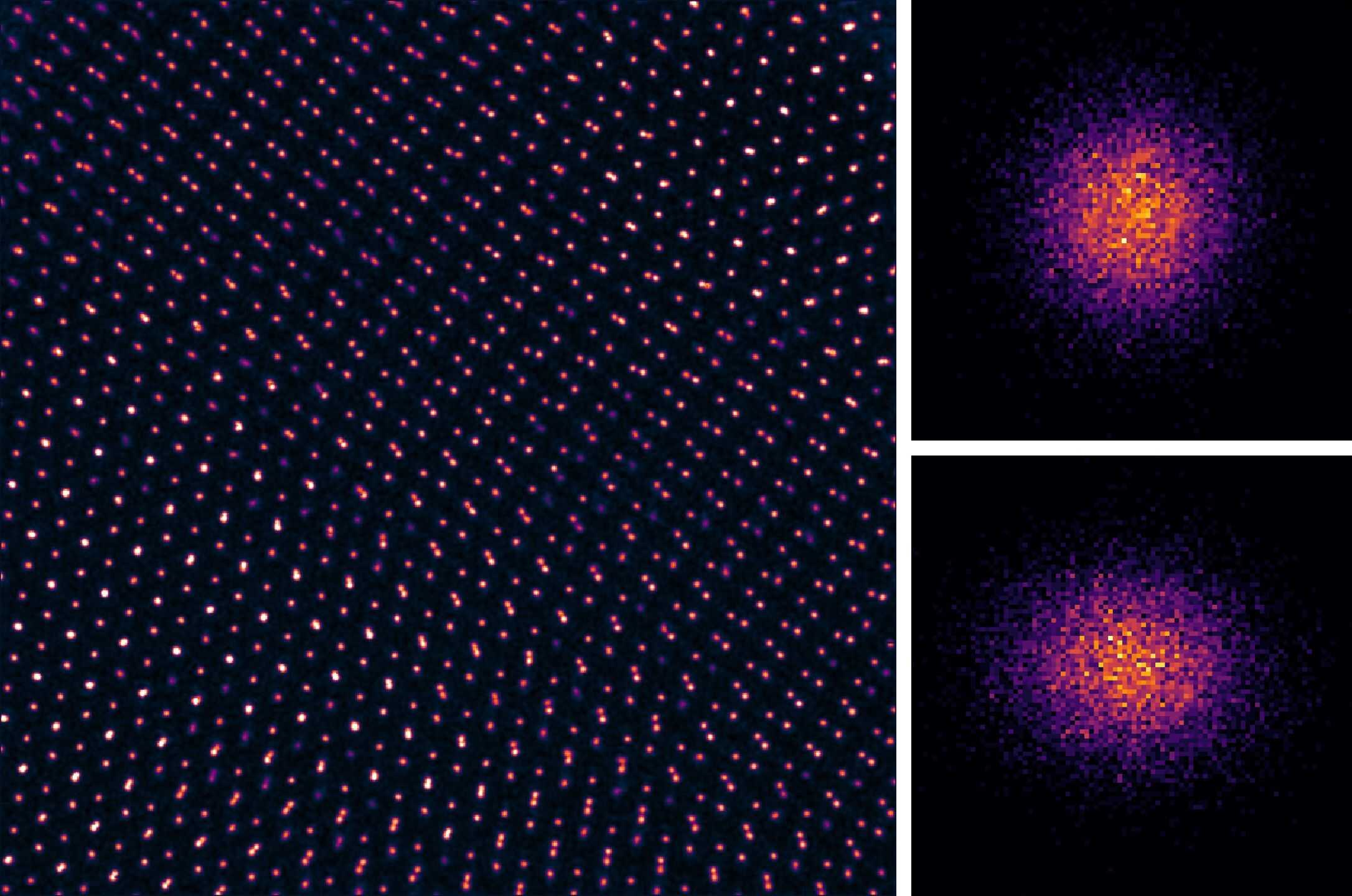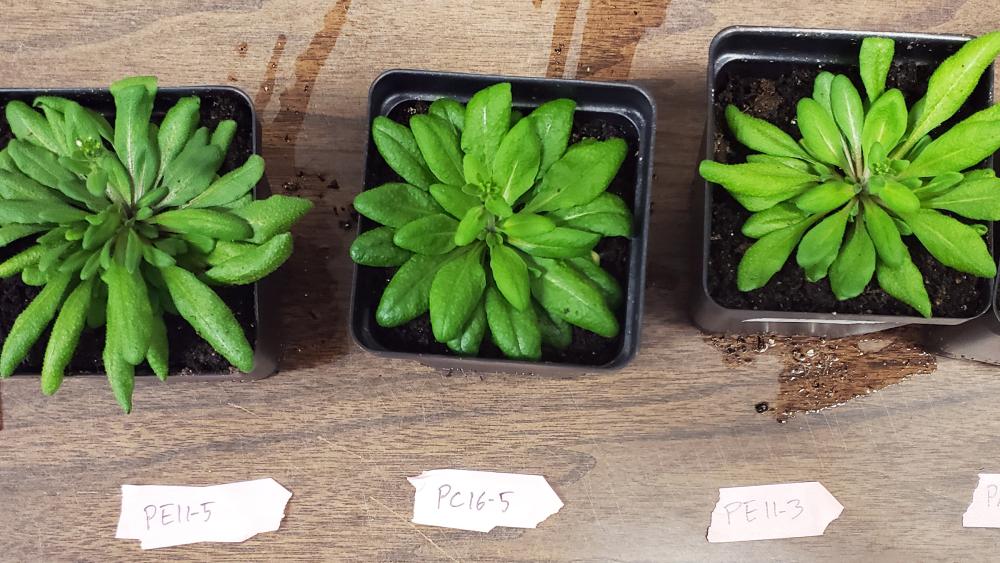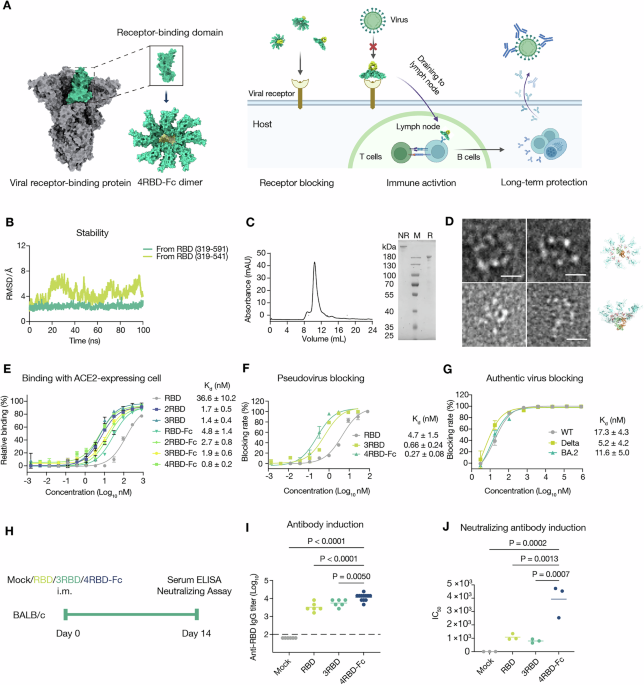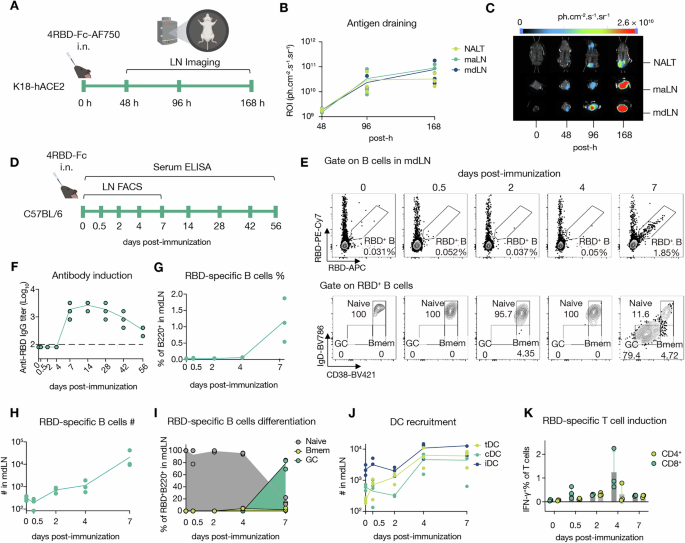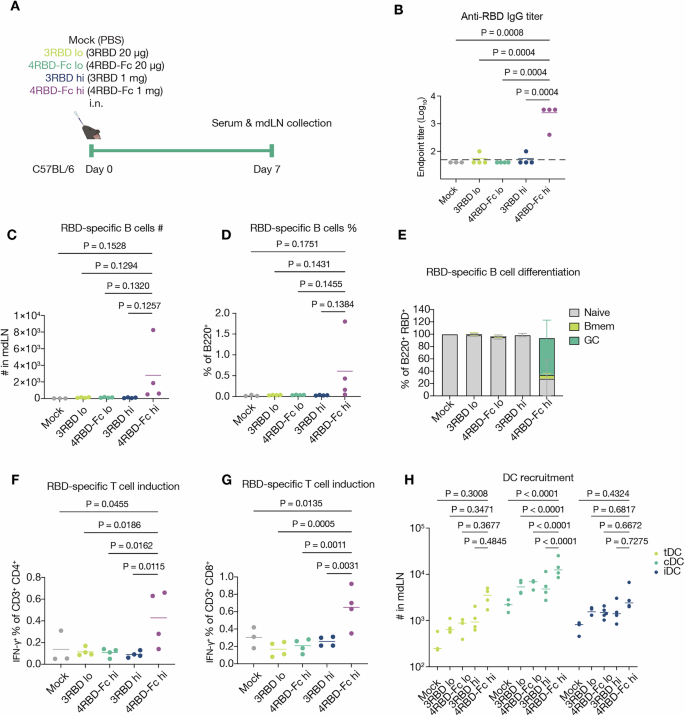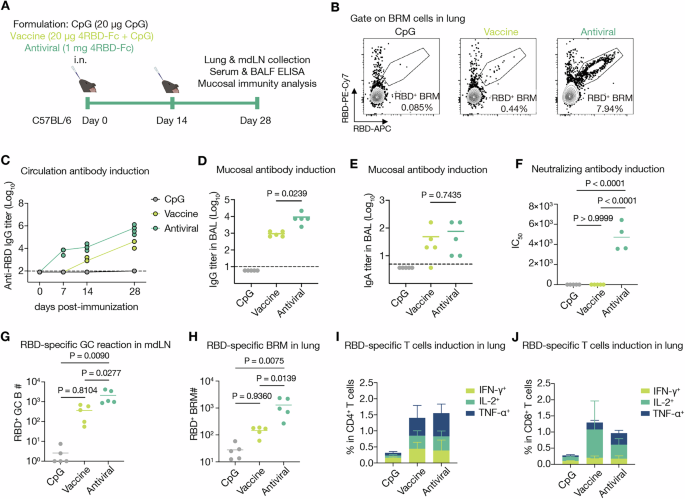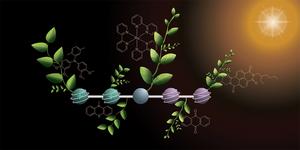Structure-based RBD multimer design to enhance stability and human ACE2 binding affinity
Extensive characterization of spike protein residues 319-541, previously considered the RBD required for human ACE2 (hACE2) binding26,27, showed that this recombinant RBD protein fragment tends to dimerize, potentially forming higher-order multimers, due to the presence of an unpaired cysteine residue (C538) close to the C-terminus16,28. To prevent this dimerization activity in our constructs, we used a previously reported cryo-electron microscopy structure (PDB ID: 6VXX) to design a longer truncated RBD spanning residues 319-591 that allows formation of disulfide bonds between C538 and C590 (Fig. 1A)16. Subsequent molecular dynamics (MD) simulations showed that RBD (319-591) was more stable than RBD (319-541), and had a lower RMSD than that of RBD (319-541) (RMSD = 2.5 Å versus ~5 Å, RBD (319-591) versus RBD (319-541); Fig. 1B), we therefore used RBD (319-591) in the following experiments.
In order to counteract the binding of the trimeric SARS-CoV-2 spike protein to the hACE2 receptor, the recombinant RBD needs to exhibit high affinity towards hACE2. To achieve this, we engineered several RBD (319–591) constructs, including a monomer, a set of oligomers (2–3 RBD units in length), and a set of oligomers (2–4 RBD units) fused to a human IgG1 Fc domain (Fig. 1A), as attempts to incorporate additional RBD copies led to significantly reduced protein yields. We then verified their size and purity through SDS-PAGE and size-exclusion chromatography (Fig. 1C and Supplementary Fig. 1A).
Characterization of the tertiary structure of 4RBD-Fc by negative-stain electron microscopy (EM) revealed that it tends to form a beads-on-a-string-like architecture, with multiple RBD subunits loosely arranged around a central base, suggesting the dimerization of two 4RBD-Fc molecules (Fig. 1D). Each RBD subunit appeared intact and was connected via flexible glycine–serine linkers, while the central base was composed of two dimerized human IgG1 Fc domains. Due to the flexible linkers, the exact orientation of the receptor-binding motifs (residues 437–508) could not be precisely resolved; however, the arrangement appears compatible with accessibility for ACE2 binding.
To probe interactions between the RBD oligomers and hACE2, we next conducted cell-surface-binding assays using flow cytometry. Series-diluted RBD constructs were incubated with hACE2-expressing cell line (293T-hACE2) in the presence of 100 nM AlexaFluor 488-labeled RBD protein. This analysis revealed that the Kd value of RBD monomer was 36.6 ± 10.2 nM, whereas the Kd values for the oligomers were 1.7 ± 0.5 nM (2RBD), 1.4 ± 0.4 nM (3RBD), 4.8 ± 1.4 nM (RBD-Fc), 2.7 ± 0.8 nM (2RBD-Fc), 1.9 ± 0.6 nM (3RBD-Fc), and 0.8 ± 0.2 nM (4RBD-Fc) (Fig. 1E). 3RBD in the RBD oligomers and 4RBD-Fc in the Fc-fused RBD oligomers exhibit the two strongest binding capability for hACE2, being 26-fold and 46-fold higher than the RBD monomer, respectively. Therefore, they were chosen for further experiments. These results suggested that the oligomeric and Fc-fused RBD proteins retained the functionality of native RBD and could potentially interact with ACE2 more robustly.
Evaluation of 4RBD-Fc as an effective broad-spectrum blocker for SARS-CoV-2 variants in vitro
The inhibitory effects of RBD oligomers on viral entry was assessed using SARS-CoV-2 pseudovirus blocking assays. 293T-hACE2 cells, pre-incubated with RBD oligomers and then infected with a luciferase-reporter pseudovirus displaying the wild-type (WT) SARS-CoV-2 spike protein29, exhibited reduced luminescence compared to non-pre-incubated cells, suggesting inhibition of spike protein-mediated entry. Dose-dependent luminescence reduction post-infection was observed with RBD monomer, 3RBD, and 4RBD-Fc (Fig. 1F), while 4RBD-Fc showed the highest inhibition (IC50 = 0.27 ± 0.08 nM), outperforming both RBD monomer (IC50 = 4.7 ± 1.5 nM) and 3RBD (IC50 = 0.27 ± 0.08 nM). Consequently, 4RBD-Fc was selected for further study.
Acknowledging the limitation of pseudovirus studies, we further extended our investigation to clinically isolated SASR-CoV-2 viruses using Vero E6 cells in a biosafety level 3 (BSL-3) laboratory. Similar to the results of pseudovirus blocking assays, 4RBD-Fc pre-incubation effectively reduced viral load (measured by qRT-PCR) in Vero E6 cells infected with WT SARS-CoV-2 and two variants, including Delta (B.1.617.2) and BA.2 (B.1.1.529.2), with IC50 of 17.3 ± 4.3 nM, 5.2 ± 4.2 nM, and 11.6 ± 5 nM, respectively (Fig. 1G). These outcomes suggest that the interaction of 4RBD-Fc with ACE2 effectively blocks the entry of various SARS-CoV-2 variants in vitro. Overall, these results demonstrate the exceptional blocking activity of 4RBD-Fc for SARS-CoV-2 among the other RBD constructs, and its potential as a broad-spectrum antiviral agent for SARS-CoV-2 variants.
Immunogenicity assessment of RBD oligomers
Next, we assessed whether these RBD oligomers retained immunogenicity by testing a single dose of intramuscular (i.m.) immunization with 10 μg of RBD, 3RBD, or 4RBD-Fc antigens in BALB/c mice, using CpG and aluminum hydroxide gel (Alum) as adjuvants. Serum samples were then collected for antibody titers and pseudovirus neutralization analysis (Fig. 1H). Enzyme-linked immunosorbent assay (ELISA) analysis of anti-RBD IgG antibodies in serum revealed that the 4RBD-Fc group exhibited the highest antibody titers (1 × 104), surpassing those of the RBD (3.2 × 103) and 3RBD groups (5 × 103) (Fig. 1I). Additionally, pseudovirus neutralization assays demonstrated that serum from the 4RBD-Fc group had a significantly higher neutralization capacity against WT SARS-CoV-2 pseudovirus (IC50 = 3934) compared to the RBD (IC50 = 1086) and 3RBD groups (IC50 = 796.8) (Fig. 1J). These data suggest that the RBD oligomers retained their immunogenicity, with 4RBD-Fc generating stronger binding and neutralizing antibody levels compared to RBD and 3RBD.
Restricted 4RBD-Fc distribution in the respiratory system avoids inducing inflammation or allergic reactions
To assess the suitability of 4RBD-Fc as an antiviral agent, we investigated its in vivo distribution kinetics via i.n. administration of 1 mg AlexaFluor 750-labeled 4RBD-Fc (4RBD-Fc-AF750) to K18-hACE2 mice (Fig. 2A). Given that murine ACE2 receptor does not bind to the RBD of SARS-CoV-230, we employed K18-hACE2 mice, which express hACE2 driven by the cytokeratin-18 (K18) promoter in epithelial cells31. Bioimaging of whole mice in vivo and in ex vivo dissected organs showed that 4RBD-Fc rapidly localized to lungs within 4 hours (Fig. 2B–E) and remained detectable in both the upper and lower respiratory tract (Fig. 2C, D) for at least 168 hours (Fig. 2B, E), indicating high stability of 4RBD-Fc in the respiratory tract microenvironment. During the initial 96 hours post-administration, the AF750 signal in the bioimaging data was confined to the respiratory tract, suggesting restricted localization of the 4RBD-Fc (Supplementary Fig. 2A–C). However, at 96 hours post-administration, 4RBD-Fc signal could be observed in ex vivo liver and kidney tissues, suggesting possible degradation or transport of 4RBD-Fc (Supplementary Fig. 2B, C). Importantly, by 336 hours (14 days) post-administration, AF750 signals had become undetectable in the respiratory tract in the majority of mice, with only one mouse showing a faint signal in the nasal cavity and lungs—demonstrating effective clearance of the protein from the respiratory system over time (Fig. 2E). Overall, these findings indicate that 4RBD-Fc exhibits strong and specific localization to the respiratory tract at early stage, prolonged local stability, and minimal systemic exposure, making it a promising candidate for intranasal antiviral therapy.
To further assess the safety of intranasally administered 4RBD-Fc, we conducted both pulmonary and systemic evaluations in K18-hACE2 mice. Mice were intranasally administered with either 1 mg of 4RBD-Fc or an equal volume of PBS (vehicle control) (Supplementary Fig. 3A). Throughout the 7-day observation period, mice were monitored daily for body weight, behavior (including activity and grooming), and general appearance (fur condition and posture), and no adverse clinical signs were observed in the 4RBD-Fc-treated group compared to the vehicle group. At 7 days post-administration, flow cytometry analysis of lung single-cell suspensions showed no significant difference in immune cell infiltration, including total leukocytes and four types of granulocytes (neutrophils, eosinophils, basophils, and mast cells), between the two groups (Supplementary Fig. 3B).
Given that allergic reactions are characterized not only by eosinophil infiltration but also by T helper type 2 (Th2) immune responses, we further employed an in vitro RBD peptide library stimulation method to assess the presence of RBD-specific Th2 cells. Lung cells were stimulated with the RBD peptide library for 6 hours, followed by intracellular cytokine staining and flow cytometric detection of CD3+CD4+IL-4+ cells (Supplementary Fig. 3C). No significant difference in pulmonary Th2 cell frequency was observed between groups (Supplementary Fig. 3D), suggesting that intranasal 4RBD-Fc did not trigger a Th2-skewed immune response. These findings demonstrate that intranasal administration of 4RBD-Fc did not induce pulmonary inflammation, allergic reactions, or systemic toxicity in vivo.
Prophylactic and therapeutic effects of i.n. administered 4RBD-Fc in SARS-CoV-2-infected mice
To assess the antiviral activity of 4RBD-Fc as a preventive or therapeutic treatment for SARS-CoV-2, we administered 4RBD-Fc (1 mg i.n.) or the PBS vehicle control to K18-hACE2 mice at either 2 hours before (PrEP group) or 24 or 48 hours after (PEP group) infection with the SARS-CoV-2 Delta strain with 4 × 103 plaque-forming units (PFU) per mouse (Fig. 2F), as a well-established infection system32. At 5 days post-infection (dpi), significant weight loss (21.5%) was observed in the vehicle group, with all animals being euthanized by 5 dpi (a ≥ 15% loss of body weight compared to baseline was considered as the humane endpoint) (Fig. 2G). In contrast, all mice in the PrEP group and 66.7% (4/6) of the mice in the PEP group survived at 5 days post-infection (dpi). Both PrEP and PEP groups showed markedly lower viral loads in the upper respiratory tract (lower than LOD in PrEP, 2.8 × 103 copies/ml in PEP versus 8.3 × 104 copies/ml in vehicle controls) and lower respiratory tract (lower than LOD in PrEP, 3.1 × 104 copies/ml in PEP versus 8 × 107 copies/ml in vehicle controls), as confirmed by viral titer assays of throat swabs and lung tissues. Complete viral clearance (viral load < limit of detection: 1 × 103 copies/ml) was achieved in 66.7% (2/3) of the PrEP group (Fig. 2H, I). These results thus supported that 4RBD-Fc administration could effectively reduce viral load of the SARS-CoV-2 Delta variant in vivo.
Given these findings, we next evaluated whether 4RBD-Fc affected transmission of SARS-CoV-2. Index mice, infected with the Delta strain at 4 × 104 PFU, ten-fold higher than lethal concentrations, were co-housed with contact mice treated with 4RBD-Fc or PBS vehicle. By 5 dpi, all index mice succumbed, whereas none died in the contact groups (Fig. 2J). Viral titer assays indicated that vehicle-treated contact mice had obvious accumulation of viral loads (8 × 103 copies/ml in throat swabs and 2.6 × 104 copies/ml in lungs at 5 dpi) following contact with the index group (Fig. 2K), whereas no virus (below limit of detection) was detected in the 4RBD-Fc contact group by 5 dpi. These data were consistent with viral titer assays from throat swabs and lung tissue samples by 5 dpi (Fig. 2K, L). However, we observed detectable viral titers in the throat swabs of one mouse in the 4RBD-Fc contact group at both 1 dpi and 3 dpi.
Histopathological examination of the vehicle controls and index groups revealed diffuse hemorrhage, severe alveolar thickening, and bronchiole structure loss, indicative of fatal pneumonia progression, whereas only mild alveolar thickening was noted in the vehicle-treated contact groups (Supplementary Fig. 4A). Notably, no lung lesions were observed in the PrEP and 4RBD-Fc-treated contact groups. Altogether, these results advocate for the potential of i.n. delivered 4RBD-Fc as both prophylactic and therapeutic agent against SARS-CoV-2 infection and transmission.
Activation of anti-RBD de novo immune responses in respiratory-associated lymphoid tissues via i.n. administration of unadjuvanted 4RBD-Fc
Next, we examined the ability of 4RBD-Fc to drain to lymph nodes after i.n. administration. We assessed the distribution of 4RBD-Fc-AF750 in secondary lymphoid organs of K18-hACE2 mice (Fig. 3A). After 1 mg 4RBD-Fc-AF750 i.n. administration, 4RBD-Fc rapidly drained to respiratory-associated lymphoid tissues such as nasal-associated lymphoid tissues (NALT), mandibular lymph nodes (maLN), and mediastinal lymph nodes (mdLN) (Fig. 3B, C), but not to other secondary lymphoid tissues at early time points (Supplementary Fig. 4A–C). The 4RBD-Fc-AF750 signal in lymphoid tissues progressively rose, showing a 15.7-fold (NALT), 22.7-fold (maLN), and 12.6-fold (mdLN) increase by 96 hours, and a 17.2-fold (NALT), 60.1-fold (maLN), and 41.7-fold (mdLN) increase by 168 hours compared to 48 hours, indicating active accumulation of 4RBD-Fc in respiratory-associated lymphoid tissues by 96 hours (Fig. 3B). In addition, at 96 and 168 hours post-administration, weak but detectable 4RBD-Fc signals were also observed in other secondary lymphoid organs, suggesting limited dissemination beyond the respiratory-associated lymphoid tissues at later stages.
We further validated whether 4RBD-Fc draining to respiratory-associated lymphoid tissues could activate local immune responses, including innate and adaptive immunity. We i.n. administered 1 mg of 4RBD-Fc to a group of C57BL/6 mice and collected serum and mdLN at 0, 12, 48, 96, and 168 hours for analysis (Fig. 3D). By 168 hours post-administration, anti-RBD IgG antibodies became detectable in the serum of these mice at a titer of 9.3 × 102 using ELISA (Fig. 3F). Since the activation of B cell responses involves the expansion and differentiation of antigen-specific B cells, we used fluorescence-labeled RBD tetramers and flow cytometry to detect RBD+ B cells in mdLN (Fig. 3E, G). Robust RBD+ B cell expansion was detected at 168 hours in mdLN (Fig. 3G), characterized by significant increases in both proportions (1.2% versus 0.05%) and numbers (2 × 104 versus 2 × 102) of RBD+ B cells (Fig. 3G, H). Through further B cell phenotypic analysis, we observed differentiation in these RBD+ B cells. The proportion of Naive B cells (Naive, CD38+IgD+) significantly decreased among RBD+ B cells at 168 hours (95.2% at 96 hours versus 15.7% at 168 hours). Concurrently, the proportion of Memory B cells (Bmem, CD38+IgD–) in RBD+ B cells increased at 96 hours (0% at 48 hours versus 4.1% at 96 hours), and germinal center B cells (GC, CD38–IgD–) appeared at 168 hours (0% at 96 hours versus 78.9% at 168 hours), suggesting differentiation of RBD+ Naïve B cells into GC and Bmem (Fig. 3I). These data indicate that i.n. administration of 4RBD-Fc triggered an RBD-specific B cell response in mdLN.
To assess the longevity of the anti-RBD immune response elicited by a single intranasal dose of 4RBD-Fc (1 mg, no adjuvant), we measured serum IgG endpoint titers at Days 14, 28, 42 and 56 post-administrations (Fig. 3E). Titers at Day 42 showed less than a 20% decline versus Day 14, indicating sustained antibody production. Consistently, serum collected at Day 42 exhibited pseudovirus IC50 values statistically indistinguishable from those at Day 14 (Supplementary Fig. 7F), demonstrating persistent functional neutralization capacity. These findings suggest that, although additional long-term follow-up is needed to fully confirm durability, the neutralizing antibody activity remains effective at least up to Day 42 post-immunization, providing evidence for lasting antiviral protection.
To better understand 4RBD-Fc elicited immunity, we investigated the dynamic changes of immune cell subsets within these draining lymph nodes using flow cytometry, including dendritic cells (DCs), and antigen-specific T and B cells. Migratory DCs (tDCs) have been demonstrated to actively collect respiratory antigens and initiate adaptive immunity in mdLN33,34. In mdLN, a cohort of tDCs was the first to respond to i.n. 4RBD-Fc, showing a significant increase at 48 hours post-administration (2.3 × 102 at 0 hour versus 1.3 × 103 at 48 hours) (Fig. 3J). By 96 hours, lymph node cells stimulated with an RBD peptide library exhibited a marked increase in IFN-γ+CD4+ (0.06% at 0 hour versus 0.32% at 96 hours) and IFN-γ+CD8+ T cells (0.06% at 0 hour versus 1.25% at 96 hours), indicating the initiation of a Th1-biased RBD-specific cellular immunity (Fig. 3K). Similar RBD-specific B cell responses were observed in NALT and maLN, but not in the lungs (Supplementary Fig. 6A–F). Together, these findings provide cellular-level evidence that i.n. administration of 4RBD-Fc activates RBD-specific immunity in respiratory-associated lymphoid tissues.
Requirement of both Fc-fusion and antigen dosage for adjuvant-free mucosal immunogenicity of 4RBD-Fc
Typically, protein antigens require adjuvants to activate mucosal immunity23,35,36. However, the antiviral formulation of 4RBD-Fc demonstrates the ability to achieve mucosal immune activation without adjuvants, which may attribute to its unique structure or dosage. To investigate the mechanism of this adjuvant-free immune activation, we administered 4RBD-Fc or 3RBD—which is also multimeric but lacks Fc-fusion—at low (lo, 20 μg) or high doses (hi, 1 mg) via i.n. administration in C57BL/6 mice, all without adjuvants. While the mock group received an equal volume of PBS (Fig. 4A). ELISA analysis of mice serum at day 7 revealed that anti-RBD IgG antibodies in the 4RBD-Fc (hi) group has an average titer of 2.5 × 103. Conversely, only 25% (1/4) of mice in 3RBD (lo) and 3RBD (hi) groups showed detectable anti-RBD antibodies at a much lower titer of 1 × 102 (Fig. 4B). These results demonstrated effective anti-RBD antibody response could only be achieved in the 4RBD-Fc (hi) group. Flow cytometry analysis of RBD-specific B cells in 4RBD-Fc (hi) group revealed an RBD-specific GC response and B cell differentiation, marked by an increase in percentages and numbers of RBD+ B cell (Fig. 4C, D), a decrease in naive B cells (98.1% versus 28.1%), and an increase in GC B cells (0% versus 60%) and Bmem (0.6% versus 5.9%) (Fig. 4E) in mdLN. Meanwhile, only a notably higher frequencies of RBD peptide reactive IFN-γ+CD4+ and IFN-γ+CD8+ T cells were observed in the 4RBD-Fc (hi) group, compared to all other groups (Fig. 4F, G). Consistently, DC subsets in mdLN were also significantly elevated in the 4RBD-Fc (hi) group (Fig. 4H). This indicating that RBD-specific T cell response are exclusively generated in the 4RBD-Fc hi group. Together, these results suggest that both Fc-fusion and high antigen dosage contribute to the adjuvant-free mucosal immunogenicity of 4RBD-Fc in mice.
Enhanced systemic and mucosal immunity induced by the antiviral formulation of 4RBD-Fc compared to the vaccine formulation
To assess whether the immune response elicited by the antiviral drug formulation of 4RBD-Fc is sufficient to provide viral protection, we first compared it to the immune response induced by a validated mucosal vaccine formulation23,37,38,39. By Fc-fused protein antigens to target the FcRn receptors expressed on respiratory epithelial cells, mucosal vaccines facilitate the crossing of antigens through the mucosal barrier and activate mucosal immunity in the presence of adjuvants23,24,39. Since human IgG1-Fc can bind to murine FcRn with similar affinity24, the 4RBD-Fc construct meets this criterion. Therefore, we developed a mucosal vaccine formulation of 4RBD-Fc (20 μg with CpG adjuvant) and compared the systemic and mucosal immune responses it induced to those triggered by the antiviral drug formulation (1 mg 4RBD-Fc without adjuvant), while the mock group received 20 μg CpG i.n. only (Fig. 5A). Following twice i.n. administration in C57BL/6 mice, both formulations induced respiratory mucosal immunity (Fig. 5B–J), including lung-resident memory B cells (BRMs) (Fig. 5B, H), mucosal antibodies in bronchoalveolar lavage (BAL) (Fig. 5D), GC responses in mdLN (Fig. 5G) and T cells in the lungs (Fig. 5I, J). Notably, the antiviral formulation demonstrated a rapid antibody production, with anti-RBD IgG antibodies detectable in serum by day 7 (6.3 × 103), and consistently surpassed the vaccine formulation at subsequent time points (1.6 × 104 versus 1.3 × 103 at day 14, 6.3 × 105 versus 3.2 × 104 at day 28) (Fig. 5C). Of note, the antiviral formulation induced 10-fold higher mucosal IgG antibodies titer in BAL (9.2 × 103) compared to the vaccine formulation (9.3 × 102) (Fig. 5D, E). At day 28, serum from mice treated with antiviral formulation showed neutralizing activity against WT SARS-CoV-2 pseudovirus (IC50 = 4716), while the vaccine formulation did not exhibit detectable neutralizing activity (IC50 not determined) (Fig. 5F). Flow cytometry analysis revealed that antiviral formulation induced significant more RBD+ GC B cells in mdLN (2.1 × 103 versus 3.6 × 102) (Fig. 5G). To distinguish lung-resident B cells from circulating B cells, anti-CD45-APC antibody was administered intravenously (i.v.) to label circulating immune cells40. Cells that were CD19+CD45i.v.–CD38+IgD– were considered to be lung-resident memory B cells41. The antiviral formulation (1.3 × 103) elicited 8.9-fold more RBD+ BRMs than the vaccine formulation (1.5 × 102) in the lungs (Fig. 5H). Both formulations induced more RBD-specific T cells in the lungs comparing to the mock group, including IL-2+ and TNF-α+CD4+ (Fig. 5I) and TNF-α+CD8+ T cells (Fig. 5J), detected via RBD peptide library stimulation and intracellular cytokine staining. Together, these data demonstrated that when administered intranasally, the antiviral 4RBD-Fc formulation elicits a stronger mucosal and systemic immune response than the vaccine formulation, while the vaccine formulation remains effective via intramuscular administration.
4RBD-Fc antiviral formulation outperforms vaccine formulation in providing immediate and sustained protection against SARS-CoV-2 variant
We postulated that the antiviral formulation of 4RBD-Fc would not only protect mice from imminent infection, as demonstrated in Fig. 2, but also offer sustained protection through its rapid and strong vaccine-like immune activation effect. As such, we compared the protectivity of 4RBD-Fc in antiviral formulation with vaccine formulation against SARS-COV-2 challenge (Fig. 6A). The vaccine group of K18-hACE2 mice was primed with 20 μg 4RBD-Fc adjuvanted with CpG i.n. at day 0, followed by two subsequent boosters at day 14 and day 42, then exposed to a lethal dose of SARS-CoV-2 Delta strain (4 × 103 PFU) at day 63. Equal volume of PBS containing CpG i.n. was used as mock treatments. The antiviral group of K18-hACE2 mice received a single dose of 1 mg 4RBD-Fc i.n. at day 0 and were exposed to one lethal dose of SARS-CoV-2 Delta strain (4 × 103 PFU) either at day 7 (D7) or day 14 (D14), or twice at both day 0 and day 14 (D7 + D14) (Fig. 6A). Both formulations effectively shielded K18-hACE2 mice from lethal Delta strain exposures, contrasting with the CpG i.n. group: 16.9% body weight loss and succumbed by 5 dpi (Fig. 6B). Remarkably, the antiviral formulation group, challenged with the Delta strain on either day 7 or day 14 post-administration, maintained stable body weights (100.4-100.7% of starting weight) (Fig. 6B) and exhibited significantly reduced respiratory viral loads (79-fold reduction in throat swaps and 398-fold in lungs) compared to the CpG i.n. group (Fig. 6C, D). Of note, even after two lethal challenges with the Delta strain on Day 0 and Day 14, mice receiving a single dose of the antiviral formulation survived and maintained stable body weights (105% of starting weight) (Fig. 6B). Compared to the CpG i.n. group, these mice exhibited a significant reduction in viral loads in both the upper (1.5 × 105 versus 1.2 × 103 copies/ml) and lower (2.7 × 106 versus 9 × 103 copies/ml) respiratory tracts (Fig. 6C, D). Given the amount of 4RBD-Fc in the lung was decreased by 50.4-fold at 168 hours post-administration (Fig. 2B), these results suggested that the protective effect of antiviral formulation, initially derived from hACE2 blockade, and followed by the activation and presence of anti-RBD immunity.
Both formulations of 4RBD-Fc markedly curtailed viral replication in throat swabs and lungs (Fig. 6C, D). The pulmonary virus titer assay showed a significant reduction in mice administered with i.n. vaccine formulations (21-fold), compared to the mock groups. However, a greater reduction was observed in those given the antiviral formulation: 735-fold in the D7 group, 191-fold in the D14 group, and 274-fold in the D0 + D14 group, compared to the CpG i.n. group. These data demonstrated that a single dose of antiviral formulation outperformed three rounds of vaccine formulations in reducing viral load in the lower respiratory tract for a sustained period of at least two weeks.
In conclusion, these results demonstrate that the immune responses activated by 4RBD-Fc are sufficient to protect mice from lethal doses of SARS-CoV-2 infection. Moreover, the antiviral formulations of 4RBD-Fc offer superior protection to the lungs compared to vaccine formulations. Particularly, the dual benefits of immediate hACE2 blocking effects and the subsequent development of anti-RBD immunity can be attained with just a single dose of the antiviral formulation of 4RBD-Fc.
Lower dose 4RBD-Fc maintains respiratory tract retention and induces anti-RBD immune responses
To further assess the optimal therapeutic dose of i.n. 4RBD-Fc, we conducted biodistribution and immunogenicity studies using lower doses (50 μg and 200 μg). In vivo imaging and ex vivo organ analysis on day 7 post-administration showed that mice receiving 200 μg of 4RBD-Fc-AF750 retained a greater fluorescent signal in the respiratory tract (nasal cavity and lungs) compared to the 50 μg group (Supplementary Fig. 7A–C). Moreover, lower background signal was observed in peripheral organs in the 200 μg group relative to the original 1 mg dose used in earlier experiments, indicating improved respiratory specificity at the reduced dose.
To determine whether these lower doses could still elicit an immune response, we measured serum anti-RBD IgG titers at day 7 following intranasal administration of unadjuvanted 4RBD-Fc. We found that 200 μg, but not 50 μg, was sufficient to induce a robust antibody response (Supplementary Fig. 7D, F). These results support the use of 200 μg as an effective and respiratory-specific intranasal dose that maintains both local retention and immunogenic potential.



